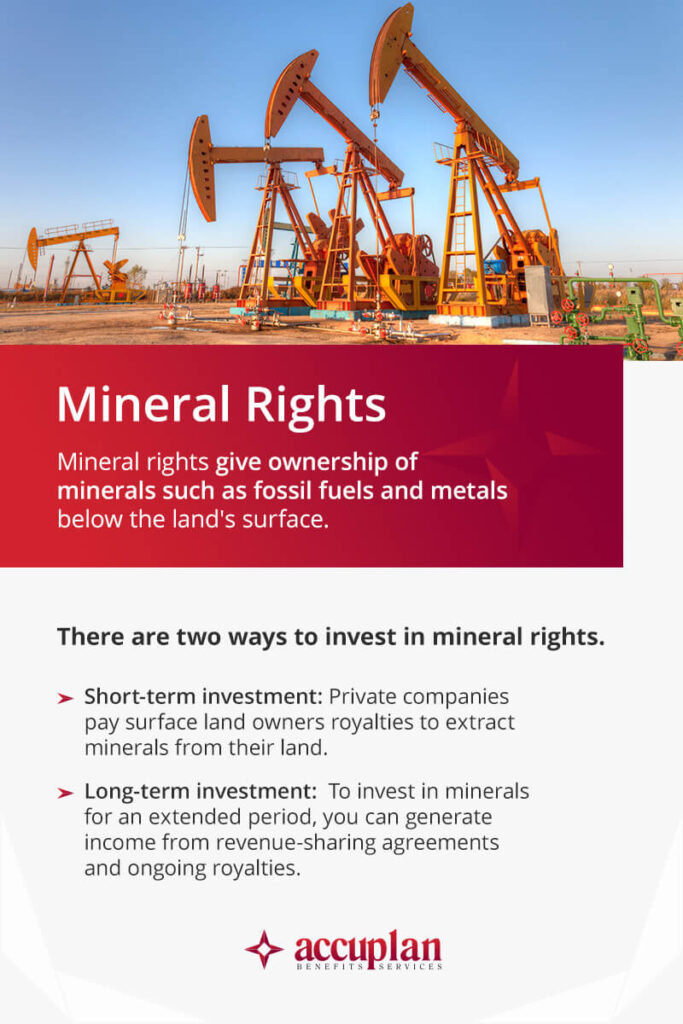
Most conventional IRAs consist of traditional investment options such as stocks, mutual funds and bonds. The beauty of a self-directed IRA is that you can explore lesser-known choices like mineral rights, offshore real estate and structured settlements. The range of self-directed IRA investment options allows you to diversify your portfolio in a way that matches your financial goals. You also have more control over how to invest your funds.
In this article, we’ll look at some of the unique investment ideas a self-directed IRA offers you.
Outside-the-Box Investment Opportunities
There are several self-directed Roth IRA alternative investments for you to explore. While nontraditional options offer significant returns, they also come with high risk. As you explore and research, consider your risk appetite and ensure you’re comfortable with your investment.
1. Limited Partnerships
A limited partnership is when two or more people agree to collaborate. A general partner oversees the business’ daily operations and has unlimited liability for the debt. They are responsible for the company’s financial obligations, such as debts and litigation. In contrast, the limited partners have little to no involvement in running the business and have less liability for the debt.
Often, investors use a limited partnership to invest in real estate and hedge funds. When you invest as a limited partner, you are only liable for business debts that match your investment amount.
Limited partners also don’t have to pay self-employment taxes because they are not active business members. The downside is that you don’t have a say in running the business. If your involvement becomes non-passive at any point, you lose your personal liability protection.
For tax purposes, limited partnerships receive the same treatment as general partnerships. The partnership will provide each limited partner with a Schedule K-1 to fill out their share of the business’ income and losses on their tax return. Because the limited partners’ involvement is passive, so are their Income and losses.
2. Offshore Real Estate
Investing in offshore real estate is when people take advantage of the benefits of purchasing a property outside their home country. Buying an offshore property offers returns such as income and capital growth. Foreign investors can also take advantage of countries known as tax havens. Purchasing offshore real estate can be expensive — it is a significant investment few can afford.

People invest in real estate abroad for several reasons:
- They plan to retire in another country.
- They want to receive income in a foreign currency.
- The offshore country has better financial regulation.
- They need to ease the financial burden of caring for dependents who live abroad.
Before investing in offshore real estate:
- Check with the Internal Revenue Service to ensure your transaction is compliant.
- Find out the reporting requirements for the country where you purchase.
- Choose the offshore country wisely, accounting for the economic, social, political and ecological environment.
Working with an attorney and a real estate professional will also ensure the transaction is legal and legitimate.
3. Structured Settlements
A structured settlement is a financial agreement between a plaintiff and a defendant where there has been a successful claim. The arrangement ensures the plaintiff receives fixed payments over a specific period, which the plaintiff’s insurance company manages.
The plaintiff can also request to switch their fixed payments to a single lump-sum payment. In this case, an investor can provide the lump sum at a discount to the total amount the plaintiff will receive. The insurance company then makes the monthly payments to the investor. Some of the benefits of investing in structured settlements include:
- The entity that pays out is a reputable insurance company, so they have the capital to pay back the amount you invest. There is a high likelihood of seeing your returns.
- Typically, the cost of investing in a structured settlement is lower than the fixed payouts you will receive.
The primary drawback of these investments is the illiquidity problem they pose. Selling your investment can be challenging, and you may lose money if you decide to sell.
4. Undeveloped Land
Undeveloped land is one of the various types of real estate you can invest in. People invest in raw land with no existing buildings, public utilities or driveways for several reasons.
- To build a home
- Recreational use
- Renting to farmers
- To use for storage

The growing demand and limited supply of undeveloped land make it an attractive investment for those who want to purchase and resell it.
Investing in undeveloped land gives you flexibility in deciding how to build. You’re starting on a blank slate with few limitations besides state and local building codes and regulations. With no structures on the land, the maintenance costs are low. All you have to do is maintain the land and fulfill other financial obligations such as property taxes and insurance. In areas with limited space, undeveloped land can offer a solid return on your investment.
Before purchasing your land, research the zoning laws in the area. These laws vary by location, so you should check that they match your intended use. You’ll need permits to build or carry out other actions on the land, such as installing a septic system, creating a driveway or digging a well — this is something to consider if you want to build.
Some land may also have easements that allow others to use the plot for a specific purpose. If yours has one, ensure you are comfortable with the arrangement.
5. Unsecured Notes
An unsecured note is a form of debt that has no collateral as security. Companies sell unsecured notes to generate funds for share repurchases and acquisitions. Because the debt has no collateral, it is riskier for lenders, which is why they come with higher interest rates.
While the risk is high with unsecured notes, they can yield a significant return because of the high interest rate. The main downside of unsecured notes is that there is no collateral to foreclose upon if the lender defaults on the loan. Unsecured notes also lack liquidity, making it challenging to resell to other investors to free up capital. Few investors will be willing to purchase an unsecured note that is close to the value you paid for it.
Unsecured notes are more susceptible to fraud. You’re relying on the borrower’s word to pay you back. If they commit fraud, your self-directed IRA may never see the money again. It’s wise to research the borrower thoroughly to mitigate this risk. Look into their background, experience and financial track record. Working with a financial advisor can also help you make a sound decision.
6. Equity Participation
Equity participation is when you own shares in a company or property. The higher your percentage of shares in a company, the greater your equity participation. The more successful the company or real estate is, the higher your gains are on the investment. Companies use equity participation for three reasons.
- Tying investors’ financial rewards to the company’s growth will ensure they act in a way that improves business profitability.
- Companies also offer equity participation to employees as an employee retention incentive.
- Businesses in emerging economies can use this for governments to reap development rewards.
Some of the benefits that come with this investment include:
- When you invest in a company, you get ownership and can exercise some control.
- Equity participation generates high returns in a short amount of time.
- It offers two avenues to generate returns — dividend income and capital appreciation.
- Your liability attributes to your investment. You have limited liability if the company files for bankruptcy.
- Company stocks are relatively liquid, making it easier for you to transfer ownership.
7. Water Investments
Everyone needs water, but it’s in short supply. As with any scarce resource, there is a valuable investment opportunity. There are some indices dedicated to tracking various water-related investments:
- The Dow Jones U.S. Water Index has 219 stocks. It comprises several international and domestic companies affiliated with the water business.
- The ISE Clean Edge Water Index has 35 stocks. It represents companies in water distribution, flow technology and water filtration.
- The S&P 1500 Water Utilities Index has only two companies — American States Water and Aqua America.
- The S&P Global Water Index has 50 companies worldwide in water utilities, infrastructure, equipment and materials.
One of the best ways to invest in water is to purchase stock from a publicly traded company that retails packaged water, provides water as a utility or has the rights to a natural water resource.
Another way to gain exposure to water commodities is to purchase shares in a water exchange-traded fund. These EFTs are an excellent option for investors who want to be hands-off, as firms manage them to maximize profit. The downside of EFTs is that their expense ratio can cause their share price to become less correlated with the asset’s value.
Water commodity futures are the riskiest form of water investment. A future is when a company or government agency that owns natural, clean water sources contracts to sell water at a specific price by a particular date.
8. Futures
Futures are derivative financial contracts that the involved people must purchase or sell at a set price on a specific expiration date. They have a fixed price regardless of the market value on that day. The set price hedges the commodity against any price movement in the assets, thereby preventing losses if the price dips.
The term “futures” covers various contracts that include the following.
- Commodity futures: These have underlying commodities such as corn, wheat, natural gas and crude oil.
- Stock index futures: You’ll find assets like the S&P 500 Index in this category.
- Currency futures: These futures focus on a specific currency, such as the dollar or euro.
- U.S. treasury futures: These are government notes and other bonds.
- Precious metal futures: Futures for commodities such as gold, copper and silver.
As a buyer, you can also sell the future beforehand, which frees you from the contract.
Investing in futures allows investors to leverage positions while putting down an initial margin of the contract. The broker or exchange used typically determines this amount. As an investor, if you leverage correctly, you may amplify your gains — if not, you risk losing out on your initial margin.
Imagine you enter into a futures contract speculating on the price of crude oil. For example, let’s say you pay $70 for a contract. Crude oil futures contracts are 1,000 barrels each, meaning your position is worth $70,000. You’ll only need to pay a fraction of the price — for example, 10%. Over the contract period, the price fluctuates dramatically, so you will need to put down a maintenance margin as an additional margin.
To continue this thought experiment, if the price has risen to $85 at the end of the contract, you earn the difference of $15,000 ($85,000 – $70,000). However, if the price has dipped to $60, you will have lost $10,000 ($70,000 – $60,000).
9. Mineral Rights

Mineral rights give ownership of minerals such as fossil fuels and metals below the land’s surface. There are two ways to invest in mineral rights.
- Short-term investment: Private companies pay surface land owners royalties to extract minerals from their land. As a land owner, you get an immediate upfront payment as a signing bonus.
- Long-term investment: To invest in minerals for an extended period, you can generate income from revenue-sharing agreements and ongoing royalties. Once you recover your initial investment, a long-term investment allows you to continue earning royalties.
So why is mineral investing a good choice? Some of the advantages of this investment include:
- If there is a high demand for the mineral, it appreciates.
- You don’t take on any expenses or drilling liability.
- They are a form of passive income because you earn royalties over your investment period.
- When you purchase mineral rights, you don’t have to pay taxes.
Investing in mineral rights also comes with risks, which include the following:
- Commodities prices fluctuate, which may affect your proceeds.
- A significant amount of exploration goes into extracting minerals. In some cases, the related costs don’t justify the investment.
- There may be legal risks associated with environmental factors and permits.
- You need a lot capital to invest in mineral rights, which you may not recoup.
10. Wind Energy
The United States aims to increase its wind energy to 20% contribution to overall power. It’s no wonder this growing industry has piqued investors’ interest. Concerns about climate change have led companies and governments to rethink their dependency on fossil fuels and gradually decarbonize. As this happens, alternative energies such as wind power are becoming lucrative investments.
You can invest in wind energy in multiple ways. Here are a few options to consider.
- Stocks: If you decide to go the stocks route, you can invest in companies that build wind turbines and provide other essential equipment for wind farms. You can also invest in companies that generate and sell wind energy. Another option is to purchase stocks in a mutual fund built around this industry or invest in an exchange-traded fund.
- Real estate: Wind farms require large land tracts. The grid then needs upgrading to generate wind energy, which requires substations, transmission towers and other substantial infrastructure. You can also invest in wind farm real estate.
- Bonds: You have two options for buying bonds. As wind companies grow and expand, they’ll sell bonds for investors to purchase. You can also buy government bonds from local municipalities looking to expand their alternative energy.
Start Investing in a Self-Directed IRA With Accuplan
There are many unique investment options for your self-directed IRA. You have virtually endless opportunities to diversify your portfolio, from more traditional stocks and mutual funds to alternative investments like wind energy and clean water. You can take control of your retirement savings, giving you peace of mind for the future.
When you open a self-directed IRA with us, you have the power to invest your funds in a wide range of assets and investments. Our onboarding process is simple — all you need to do is complete an online application to start investing today!

Our information shouldn’t be relied upon for investment advice but for information and educational purposes only. It is not intended to provide, nor should it be relied upon for accounting, legal, tax or investment advice.